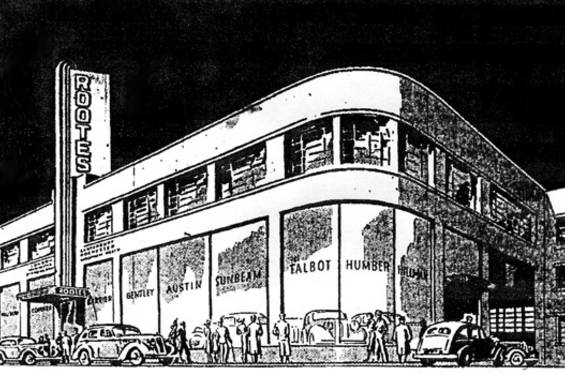This website uses cookies
This website uses cookies to enable it to function properly and to analyse how the website is used. Please click 'Close' to accept and continue using the website.



The Society is always delighted to hear of a local authority taking an active interest in preserving twentieth century buildings under their watch. This spring, a gold star sticker goes to Maidstone Borough Council in Kent for deciding that Conservation Area protection is not enough, and submitting two buildings for listing. One is the Rootes car showroom, a stunning white tiled Art Deco building set by an old millpond, just off the River Medway.
Kentish in origin, the Rootes company can be traced back to a late Victorian family bicycle shop. A car sales company was founded in 1913 and soon moved to Maidstone, becoming the largest truck and car distributor in the UK by 1924. Inconsistent supply chains led the firm to start production itself, and it thrived, acquiring rivals and expanding. The company pioneered ‘badge engineering’ keeping the valued brand names of many of these companies. In this way they were responsible for some of the classic cars of the twentieth century, including reliable Hillmans, luxurious Humbers, and Sunbeams. During World War Two Rootes produced light and heavy aircraft as well as military vehicles from an assembly line in Ryton, near Coventry, earning William Rootes a knighthood. Rootes continued to thrive in the post-war years, whilst their top driver Stirling Moss winning European car rallies. The legendary French-American designer Raymond Loewy acted as a consultant stylist on the development of the Hillman Minx, launched in 1956.
A combination of government pressures and construction problems led to substantial losses in the production of the Hillman Imp in Linwood, Scotland. The firm was drained of money and, unavailable to develop new projects, was gradually taken over by the American Chrysler Corporation, losing its name completely by 1971, before Chrysler in turn was taken over by Peugeot-Citroen.
Today, the Maidstone showroom is a poignant reminder of Rootes at the height of its success in 1938, offering cars for ‘the masses and the millionaires’ and employing over 12,000 people. The building’s designer was E Souster of Howard & Souster, a commercial London-based firm that specialised in large offices and factories, including plants for Rootes at Coventry, and General Motors and Vauxhall. Such commissions were frequently practical and plain, but at Maidstone Souster went to town on a bold modern building that showed off the glamour of motoring and the pride of the firm in re-establishing its Kent roots. The open-plan double-height flagship showrooms—hailed as ‘palatial’ by the local paper, frame a staggered tile tower, bearing the company’s name in huge letters. A petrol station sat at the corner, whilst the east wing was a garage workshop. At night the tower letters and interior of the showroom were lit, so the upper storeys appeared to float on a glass box. Sadly, the last ‘Rootes’ name was removed from the building in 2007, but the white tiles continue to shine and the building still functions well as a Peugeot showroom. The concept of a ‘British’ car industry is pretty nominal in the early twenty-first century. This makes it all the more important that we preserve the the Rootes legacy which brought speed, style and freedom of the roads to generations of British drivers.
Less fortunate is the Dex Garage in Newcastle upon Tyne. Built as a filling station, commercial garage and car park to serve the centre of the city it was also convenient for the next-door Paramount cinema. Its strong symmetry, stepped towers and rendered lettering are typical in their Art Deco character, but sadly not of a sufficiently unaltered or of high enough quality to warrant listing. The building is set to be demolished as part of a commercial redevelopment.
Jo Moore

Become a C20 member today and help save our modern design heritage.